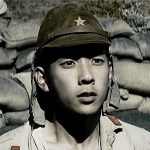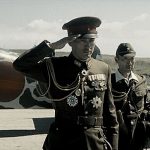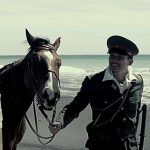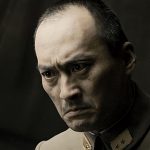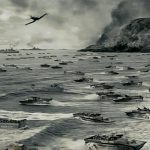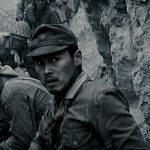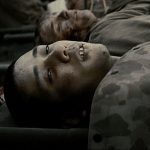Letters from Iwo Jima – 2006
This was a really good movie. It was a war film about the battle for the Japanese Island of Iwo Jima during WWII. But what I loved about it was that the entire movie was told from a Japanese perspective. Nearly all the dialogue was in Japanese with English subtitles. The cast was made up of Japanese actors. Never-mind that it was directed by a famous American director, Clint Eastwood. It was filmed just after Eastwood’s companion piece, Flags of Our Fathers, which told the story of the same battle from the American point of view. Now I want to see that movie, even though it wasn’t nominated for the Best Picture award.
This war movie was unique in the way in which it was told. By that, I mean that I’ve never before seen a war film that begins its tale long before the fighting ever starts. The Japanese soldiers are seen digging trenches on an untouched beach, but think about it. Whenever you see a war movie, you see a bunch of soldiers in bunkers or caves in the cliff-side. But who dug out those caves and trenches? What was the feeling in the company as they were preparing the island for the impending enemy assault? Who were the lowly laborers who did all the work to make the island ready for battle? Who were the officers who decided where bunkers needed to be build and where the soldiers and weaponry would be positioned? Why were they there? Where had they come from? Who were they?
The first half of the movie introduces us to some of these men. The film seemed to be an ensemble piece, but one man stood out as a bit of a lead. Private First Class Saigo, played by Kanzunari Ninomiya, was a baker who had been drafted into the military. Much of the story is told from his perspective, and he is pretty much the only soldier to survive the entire film. It is he who is responsible for saving the letters which are the driving force behind the entire movie, though this is not revealed until the last few seconds of the film.
But nearly as important was Ken Watanabe playing Saigo’s newly arrived commanding officer, General Tadamichi Kuribayachi. He is a career military man who had spent time living in California, and whose ideas about how the island should be defended are in direct contrast with several of the men under his command. He has a gentler and more compassionate style of command, which makes him popular with the low-level troops, but unpopular with the mid-level officers who believe in strict and unwavering loyalty to the Imperial Empire, putting honor and sacrifice before personal safety, and enforcing discipline through harsh words and beatings. The only officer who supports him is his friend Colonel Baron Nishi, played by Ryo Kase.
We follow the two men, and are regularly treated to voice-overs as they write letters to their loved ones, Saigo to his wife, and Kuribayachi to his. As the film’s title suggests, it is these letters that propel the film. You see, the narrative is bookended by a modern team of Japanese researchers as they explore the old caves and find a buried package. We then cut to Saigo and his friends, Private Kashiwara, played by Takashi Yamaguchi, and Private Nozaki, played by Yuki Matsuzaki, both of whom die before the end of the film. Kishiwara dies of dysentery while Nozaki, at the command of Captain Tanida, played by Takumi Bando, is driven to ritual suicide along with the last survivors of his company, by pulling the pins on grenades and waiting for them to explode.
During the final sequence of the film, after the few remaining soldiers have all gone through an unbelievable hell of blood and death, Kuribayachi orders Saigo to stay behind to destroy all of his documents and letters. But Saigo takes the General’s letters and buries them in the cave. After Kuribayachi‘s death, Saigo is eventually captured as a prisoner of war. And of course, it is these letters that we see the modern researchers unearthing right before the end credits begin to roll.
When I think of Clint Eastwood, my mind usually leaps directly to the hard boiled tough guy persona that made him famous, playing characters like Blondi from The Good, the Bad and the Ugly, or Harry Callahan from the Dirty Harry franchise. He just seems to perfectly personify that really iconic tough guy look. But it is easy to forget that he also directed other great chick-flicks like The Bridges of Madison County. He has a softer and more emotional side that he really knows how to use.
And he really did a fantastic job with Letters from Iwo Jima. He was able to create real characters that I cared about, even though I knew that most of them were doomed to die. I cared enough to be annoyed with the end of the film, when a single question was left unanswered. Was Saigo ever reunited with his wife? Personally, I’d like to think he was.
